Electronic Medical Records (EMR): A Comprehensive Study on Use
VerifiedAdded on 2023/04/11
|10
|1283
|142
Report
AI Summary
This report provides a comprehensive analysis of Electronic Medical Records (EMR) in healthcare, exploring their evolution, benefits, challenges, and future directions. It highlights the transition from paper records to digital systems, emphasizing the role of EMRs in improving the quality of patient care through reduced medical errors and enhanced communication. The report also addresses challenges such as the need for trained staff, high implementation costs, and potential for medical errors due to data input issues. Recommendations include professional training for clinical staff, regular software updates, and thorough data evaluation to mitigate errors. The study concludes that EMRs will continue to evolve, offering valuable clinical tools for improving patient outcomes and transforming the healthcare sector. Desklib offers a range of resources including past papers and solved assignments for students.

Running head: Health Care Study On EMR
Health Care Study On EMR
Name of Student:
Name of University:
Author’s Note:
Health Care Study On EMR
Name of Student:
Name of University:
Author’s Note:
Paraphrase This Document
Need a fresh take? Get an instant paraphrase of this document with our AI Paraphraser
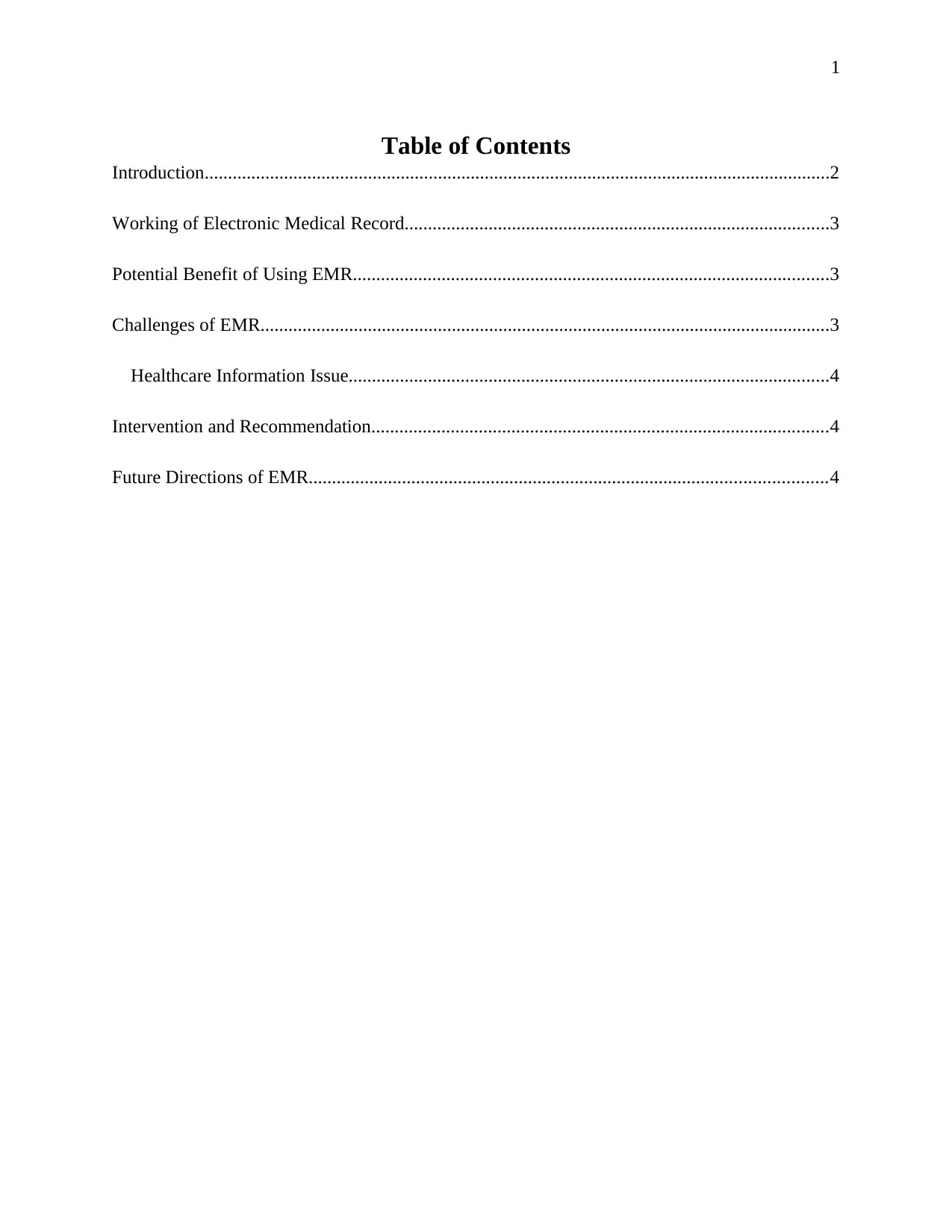
1
Table of Contents
Introduction......................................................................................................................................2
Working of Electronic Medical Record...........................................................................................3
Potential Benefit of Using EMR......................................................................................................3
Challenges of EMR..........................................................................................................................3
Healthcare Information Issue.......................................................................................................4
Intervention and Recommendation..................................................................................................4
Future Directions of EMR...............................................................................................................4
Table of Contents
Introduction......................................................................................................................................2
Working of Electronic Medical Record...........................................................................................3
Potential Benefit of Using EMR......................................................................................................3
Challenges of EMR..........................................................................................................................3
Healthcare Information Issue.......................................................................................................4
Intervention and Recommendation..................................................................................................4
Future Directions of EMR...............................................................................................................4
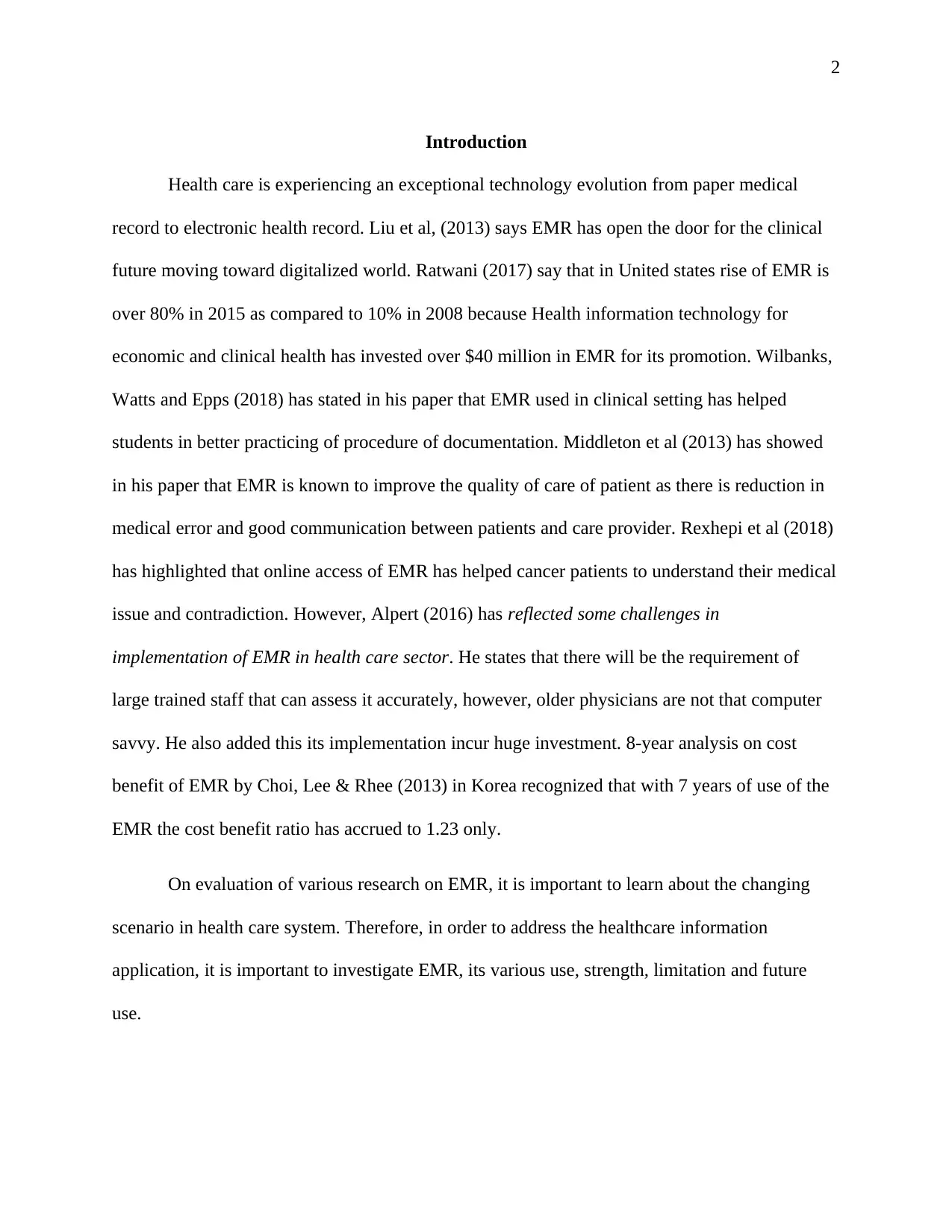
2
Introduction
Health care is experiencing an exceptional technology evolution from paper medical
record to electronic health record. Liu et al, (2013) says EMR has open the door for the clinical
future moving toward digitalized world. Ratwani (2017) say that in United states rise of EMR is
over 80% in 2015 as compared to 10% in 2008 because Health information technology for
economic and clinical health has invested over $40 million in EMR for its promotion. Wilbanks,
Watts and Epps (2018) has stated in his paper that EMR used in clinical setting has helped
students in better practicing of procedure of documentation. Middleton et al (2013) has showed
in his paper that EMR is known to improve the quality of care of patient as there is reduction in
medical error and good communication between patients and care provider. Rexhepi et al (2018)
has highlighted that online access of EMR has helped cancer patients to understand their medical
issue and contradiction. However, Alpert (2016) has reflected some challenges in
implementation of EMR in health care sector. He states that there will be the requirement of
large trained staff that can assess it accurately, however, older physicians are not that computer
savvy. He also added this its implementation incur huge investment. 8-year analysis on cost
benefit of EMR by Choi, Lee & Rhee (2013) in Korea recognized that with 7 years of use of the
EMR the cost benefit ratio has accrued to 1.23 only.
On evaluation of various research on EMR, it is important to learn about the changing
scenario in health care system. Therefore, in order to address the healthcare information
application, it is important to investigate EMR, its various use, strength, limitation and future
use.
Introduction
Health care is experiencing an exceptional technology evolution from paper medical
record to electronic health record. Liu et al, (2013) says EMR has open the door for the clinical
future moving toward digitalized world. Ratwani (2017) say that in United states rise of EMR is
over 80% in 2015 as compared to 10% in 2008 because Health information technology for
economic and clinical health has invested over $40 million in EMR for its promotion. Wilbanks,
Watts and Epps (2018) has stated in his paper that EMR used in clinical setting has helped
students in better practicing of procedure of documentation. Middleton et al (2013) has showed
in his paper that EMR is known to improve the quality of care of patient as there is reduction in
medical error and good communication between patients and care provider. Rexhepi et al (2018)
has highlighted that online access of EMR has helped cancer patients to understand their medical
issue and contradiction. However, Alpert (2016) has reflected some challenges in
implementation of EMR in health care sector. He states that there will be the requirement of
large trained staff that can assess it accurately, however, older physicians are not that computer
savvy. He also added this its implementation incur huge investment. 8-year analysis on cost
benefit of EMR by Choi, Lee & Rhee (2013) in Korea recognized that with 7 years of use of the
EMR the cost benefit ratio has accrued to 1.23 only.
On evaluation of various research on EMR, it is important to learn about the changing
scenario in health care system. Therefore, in order to address the healthcare information
application, it is important to investigate EMR, its various use, strength, limitation and future
use.
⊘ This is a preview!⊘
Do you want full access?
Subscribe today to unlock all pages.

Trusted by 1+ million students worldwide
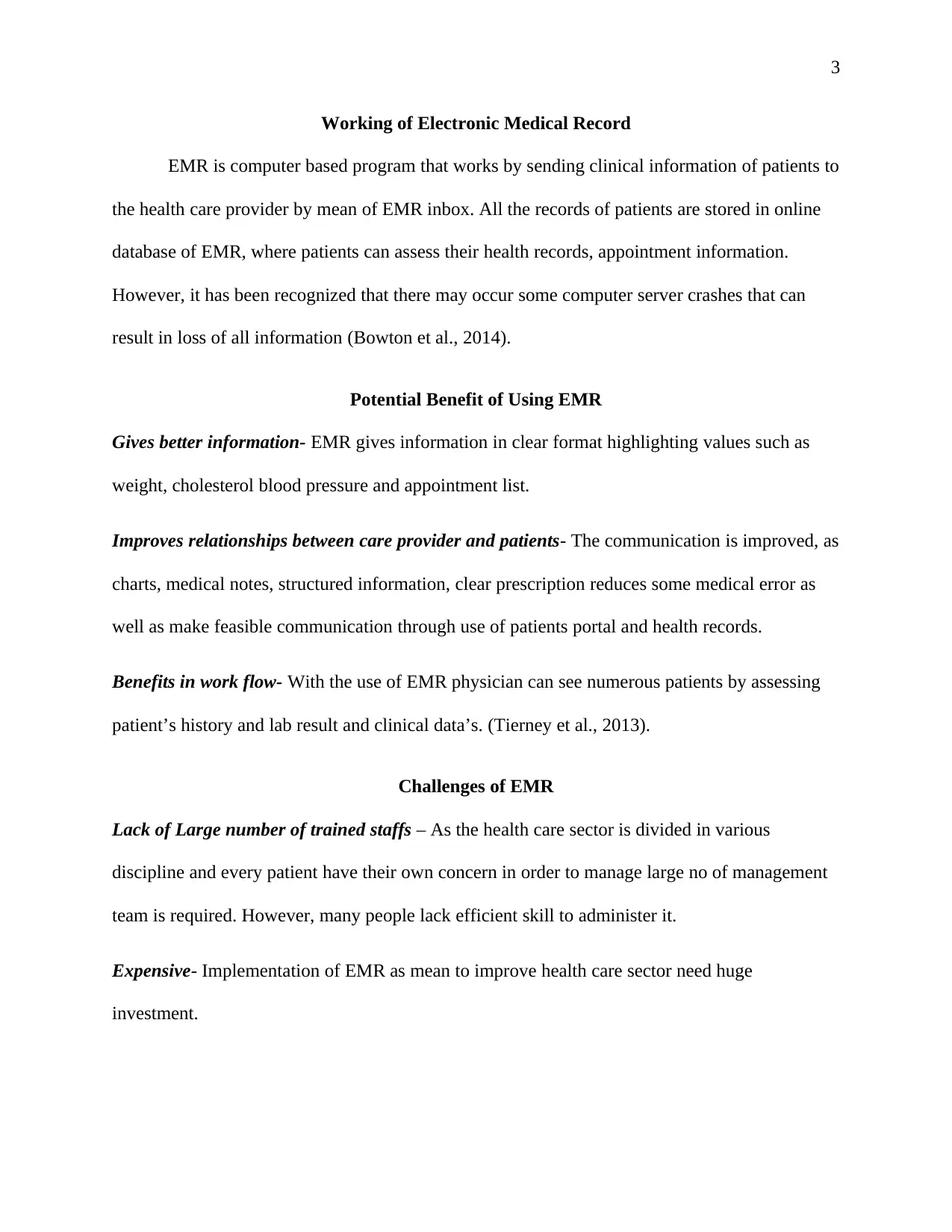
3
Working of Electronic Medical Record
EMR is computer based program that works by sending clinical information of patients to
the health care provider by mean of EMR inbox. All the records of patients are stored in online
database of EMR, where patients can assess their health records, appointment information.
However, it has been recognized that there may occur some computer server crashes that can
result in loss of all information (Bowton et al., 2014).
Potential Benefit of Using EMR
Gives better information- EMR gives information in clear format highlighting values such as
weight, cholesterol blood pressure and appointment list.
Improves relationships between care provider and patients- The communication is improved, as
charts, medical notes, structured information, clear prescription reduces some medical error as
well as make feasible communication through use of patients portal and health records.
Benefits in work flow- With the use of EMR physician can see numerous patients by assessing
patient’s history and lab result and clinical data’s. (Tierney et al., 2013).
Challenges of EMR
Lack of Large number of trained staffs – As the health care sector is divided in various
discipline and every patient have their own concern in order to manage large no of management
team is required. However, many people lack efficient skill to administer it.
Expensive- Implementation of EMR as mean to improve health care sector need huge
investment.
Working of Electronic Medical Record
EMR is computer based program that works by sending clinical information of patients to
the health care provider by mean of EMR inbox. All the records of patients are stored in online
database of EMR, where patients can assess their health records, appointment information.
However, it has been recognized that there may occur some computer server crashes that can
result in loss of all information (Bowton et al., 2014).
Potential Benefit of Using EMR
Gives better information- EMR gives information in clear format highlighting values such as
weight, cholesterol blood pressure and appointment list.
Improves relationships between care provider and patients- The communication is improved, as
charts, medical notes, structured information, clear prescription reduces some medical error as
well as make feasible communication through use of patients portal and health records.
Benefits in work flow- With the use of EMR physician can see numerous patients by assessing
patient’s history and lab result and clinical data’s. (Tierney et al., 2013).
Challenges of EMR
Lack of Large number of trained staffs – As the health care sector is divided in various
discipline and every patient have their own concern in order to manage large no of management
team is required. However, many people lack efficient skill to administer it.
Expensive- Implementation of EMR as mean to improve health care sector need huge
investment.
Paraphrase This Document
Need a fresh take? Get an instant paraphrase of this document with our AI Paraphraser

4
Medical error- Any error in inputting data concerning clinical record lead to permanent
documentation in EMR data and cause inefficient treatment (Jawhari et al., 2016).
Lack of standardized hardware and software- This has led to increase error regarding its
handling.
Healthcare Information Issue
A health information issue has been noticed while investigating literature review, that
selection of wrong person in EMR or report of medical lab, or any wrong imaging study, can
lead to serious problem as the patient will receives wrong care and medication (Heart, Ben-
Assuli & Shabtai, 2017).
Intervention and Recommendation
To improve the shortcoming of EMR for better and quality care following step need to be
taken:
Professional training should be given every clinical staffs regarding its way to use.
Regular update of software of EMR should be done to avoid any server crashes.
Health provider should get some theoretical and practical training regarding handling of
portal.
To avoid any medical error, proper evaluation of the test and input of data should be
monitored by other supporting staffs (Finlay, Rothman & Smith, 2014).
Future Directions of EMR
Undoubtedly, EMR will evolve with coming time and bring more evidence of patients to
the health care professional specifically. This is going to improve the quality of care given to
patient thus, improving the health care sector. As people are becoming more acquainted toward
Medical error- Any error in inputting data concerning clinical record lead to permanent
documentation in EMR data and cause inefficient treatment (Jawhari et al., 2016).
Lack of standardized hardware and software- This has led to increase error regarding its
handling.
Healthcare Information Issue
A health information issue has been noticed while investigating literature review, that
selection of wrong person in EMR or report of medical lab, or any wrong imaging study, can
lead to serious problem as the patient will receives wrong care and medication (Heart, Ben-
Assuli & Shabtai, 2017).
Intervention and Recommendation
To improve the shortcoming of EMR for better and quality care following step need to be
taken:
Professional training should be given every clinical staffs regarding its way to use.
Regular update of software of EMR should be done to avoid any server crashes.
Health provider should get some theoretical and practical training regarding handling of
portal.
To avoid any medical error, proper evaluation of the test and input of data should be
monitored by other supporting staffs (Finlay, Rothman & Smith, 2014).
Future Directions of EMR
Undoubtedly, EMR will evolve with coming time and bring more evidence of patients to
the health care professional specifically. This is going to improve the quality of care given to
patient thus, improving the health care sector. As people are becoming more acquainted toward

5
computer, its application will make the procedure of treatment easy and fast (Tierney et al.,
2013). This is going to be of extensive use as it is the most valuable clinical tool that focusses to
improve patient outcome.
computer, its application will make the procedure of treatment easy and fast (Tierney et al.,
2013). This is going to be of extensive use as it is the most valuable clinical tool that focusses to
improve patient outcome.
⊘ This is a preview!⊘
Do you want full access?
Subscribe today to unlock all pages.

Trusted by 1+ million students worldwide
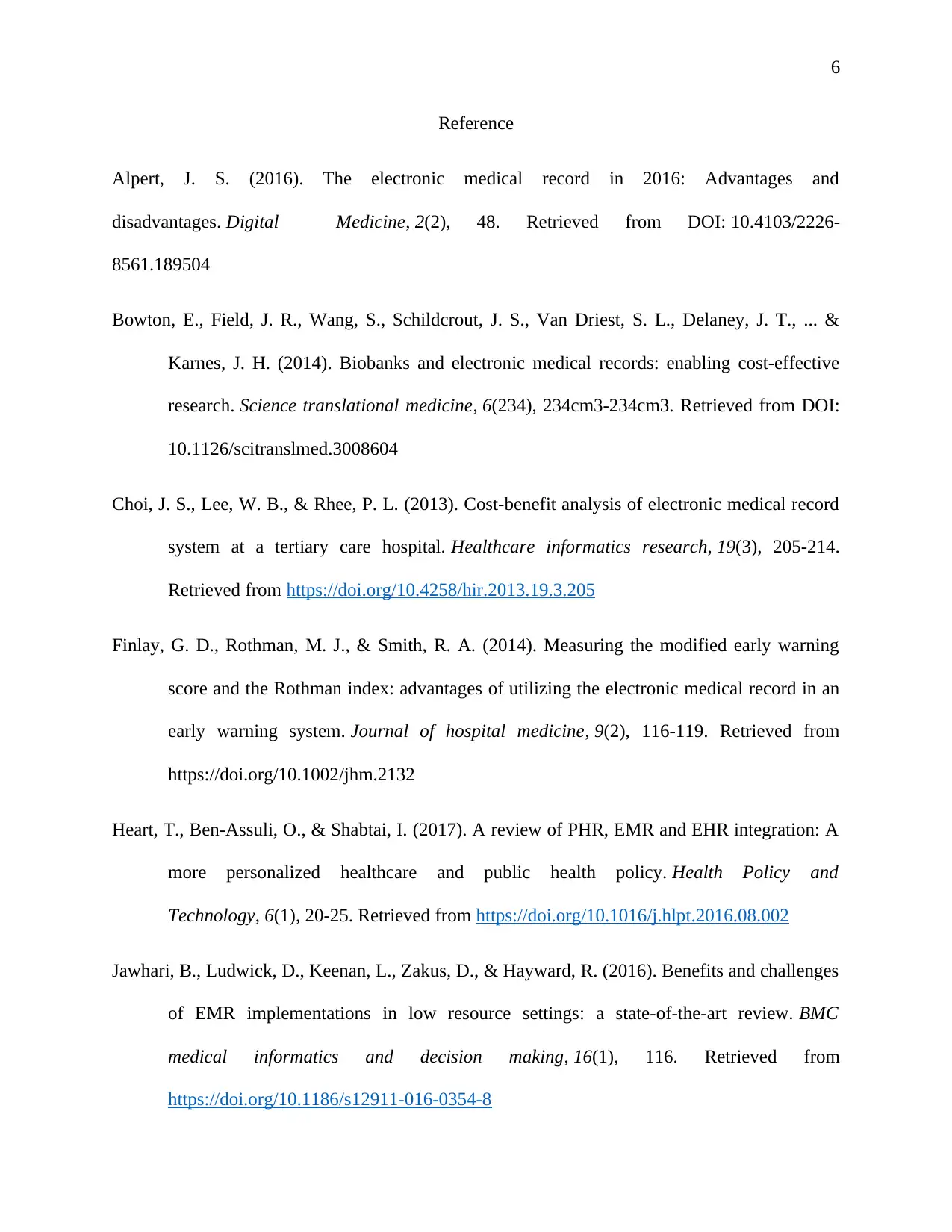
6
Reference
Alpert, J. S. (2016). The electronic medical record in 2016: Advantages and
disadvantages. Digital Medicine, 2(2), 48. Retrieved from DOI: 10.4103/2226-
8561.189504
Bowton, E., Field, J. R., Wang, S., Schildcrout, J. S., Van Driest, S. L., Delaney, J. T., ... &
Karnes, J. H. (2014). Biobanks and electronic medical records: enabling cost-effective
research. Science translational medicine, 6(234), 234cm3-234cm3. Retrieved from DOI:
10.1126/scitranslmed.3008604
Choi, J. S., Lee, W. B., & Rhee, P. L. (2013). Cost-benefit analysis of electronic medical record
system at a tertiary care hospital. Healthcare informatics research, 19(3), 205-214.
Retrieved from https://doi.org/10.4258/hir.2013.19.3.205
Finlay, G. D., Rothman, M. J., & Smith, R. A. (2014). Measuring the modified early warning
score and the Rothman index: advantages of utilizing the electronic medical record in an
early warning system. Journal of hospital medicine, 9(2), 116-119. Retrieved from
https://doi.org/10.1002/jhm.2132
Heart, T., Ben-Assuli, O., & Shabtai, I. (2017). A review of PHR, EMR and EHR integration: A
more personalized healthcare and public health policy. Health Policy and
Technology, 6(1), 20-25. Retrieved from https://doi.org/10.1016/j.hlpt.2016.08.002
Jawhari, B., Ludwick, D., Keenan, L., Zakus, D., & Hayward, R. (2016). Benefits and challenges
of EMR implementations in low resource settings: a state-of-the-art review. BMC
medical informatics and decision making, 16(1), 116. Retrieved from
https://doi.org/10.1186/s12911-016-0354-8
Reference
Alpert, J. S. (2016). The electronic medical record in 2016: Advantages and
disadvantages. Digital Medicine, 2(2), 48. Retrieved from DOI: 10.4103/2226-
8561.189504
Bowton, E., Field, J. R., Wang, S., Schildcrout, J. S., Van Driest, S. L., Delaney, J. T., ... &
Karnes, J. H. (2014). Biobanks and electronic medical records: enabling cost-effective
research. Science translational medicine, 6(234), 234cm3-234cm3. Retrieved from DOI:
10.1126/scitranslmed.3008604
Choi, J. S., Lee, W. B., & Rhee, P. L. (2013). Cost-benefit analysis of electronic medical record
system at a tertiary care hospital. Healthcare informatics research, 19(3), 205-214.
Retrieved from https://doi.org/10.4258/hir.2013.19.3.205
Finlay, G. D., Rothman, M. J., & Smith, R. A. (2014). Measuring the modified early warning
score and the Rothman index: advantages of utilizing the electronic medical record in an
early warning system. Journal of hospital medicine, 9(2), 116-119. Retrieved from
https://doi.org/10.1002/jhm.2132
Heart, T., Ben-Assuli, O., & Shabtai, I. (2017). A review of PHR, EMR and EHR integration: A
more personalized healthcare and public health policy. Health Policy and
Technology, 6(1), 20-25. Retrieved from https://doi.org/10.1016/j.hlpt.2016.08.002
Jawhari, B., Ludwick, D., Keenan, L., Zakus, D., & Hayward, R. (2016). Benefits and challenges
of EMR implementations in low resource settings: a state-of-the-art review. BMC
medical informatics and decision making, 16(1), 116. Retrieved from
https://doi.org/10.1186/s12911-016-0354-8
Paraphrase This Document
Need a fresh take? Get an instant paraphrase of this document with our AI Paraphraser
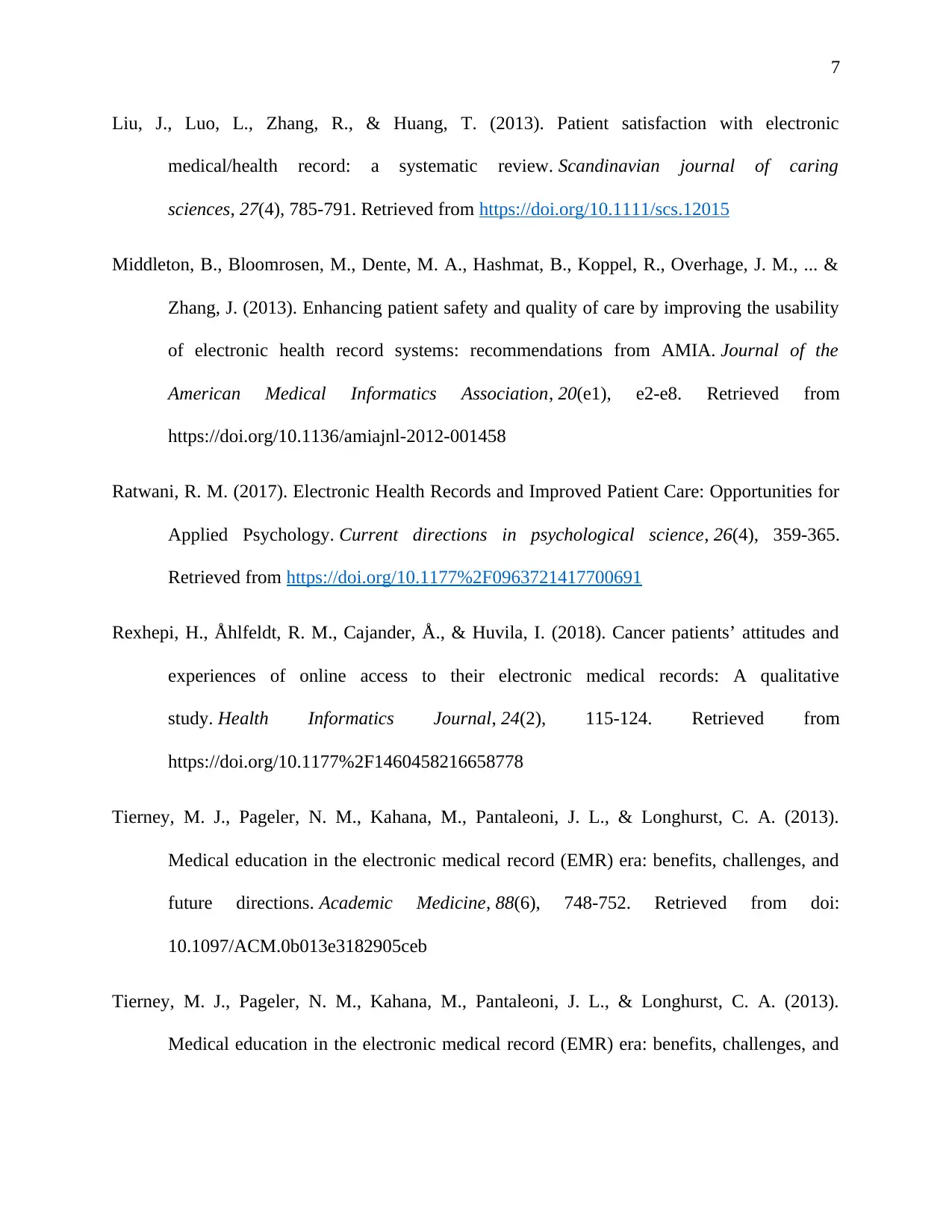
7
Liu, J., Luo, L., Zhang, R., & Huang, T. (2013). Patient satisfaction with electronic
medical/health record: a systematic review. Scandinavian journal of caring
sciences, 27(4), 785-791. Retrieved from https://doi.org/10.1111/scs.12015
Middleton, B., Bloomrosen, M., Dente, M. A., Hashmat, B., Koppel, R., Overhage, J. M., ... &
Zhang, J. (2013). Enhancing patient safety and quality of care by improving the usability
of electronic health record systems: recommendations from AMIA. Journal of the
American Medical Informatics Association, 20(e1), e2-e8. Retrieved from
https://doi.org/10.1136/amiajnl-2012-001458
Ratwani, R. M. (2017). Electronic Health Records and Improved Patient Care: Opportunities for
Applied Psychology. Current directions in psychological science, 26(4), 359-365.
Retrieved from https://doi.org/10.1177%2F0963721417700691
Rexhepi, H., Åhlfeldt, R. M., Cajander, Å., & Huvila, I. (2018). Cancer patients’ attitudes and
experiences of online access to their electronic medical records: A qualitative
study. Health Informatics Journal, 24(2), 115-124. Retrieved from
https://doi.org/10.1177%2F1460458216658778
Tierney, M. J., Pageler, N. M., Kahana, M., Pantaleoni, J. L., & Longhurst, C. A. (2013).
Medical education in the electronic medical record (EMR) era: benefits, challenges, and
future directions. Academic Medicine, 88(6), 748-752. Retrieved from doi:
10.1097/ACM.0b013e3182905ceb
Tierney, M. J., Pageler, N. M., Kahana, M., Pantaleoni, J. L., & Longhurst, C. A. (2013).
Medical education in the electronic medical record (EMR) era: benefits, challenges, and
Liu, J., Luo, L., Zhang, R., & Huang, T. (2013). Patient satisfaction with electronic
medical/health record: a systematic review. Scandinavian journal of caring
sciences, 27(4), 785-791. Retrieved from https://doi.org/10.1111/scs.12015
Middleton, B., Bloomrosen, M., Dente, M. A., Hashmat, B., Koppel, R., Overhage, J. M., ... &
Zhang, J. (2013). Enhancing patient safety and quality of care by improving the usability
of electronic health record systems: recommendations from AMIA. Journal of the
American Medical Informatics Association, 20(e1), e2-e8. Retrieved from
https://doi.org/10.1136/amiajnl-2012-001458
Ratwani, R. M. (2017). Electronic Health Records and Improved Patient Care: Opportunities for
Applied Psychology. Current directions in psychological science, 26(4), 359-365.
Retrieved from https://doi.org/10.1177%2F0963721417700691
Rexhepi, H., Åhlfeldt, R. M., Cajander, Å., & Huvila, I. (2018). Cancer patients’ attitudes and
experiences of online access to their electronic medical records: A qualitative
study. Health Informatics Journal, 24(2), 115-124. Retrieved from
https://doi.org/10.1177%2F1460458216658778
Tierney, M. J., Pageler, N. M., Kahana, M., Pantaleoni, J. L., & Longhurst, C. A. (2013).
Medical education in the electronic medical record (EMR) era: benefits, challenges, and
future directions. Academic Medicine, 88(6), 748-752. Retrieved from doi:
10.1097/ACM.0b013e3182905ceb
Tierney, M. J., Pageler, N. M., Kahana, M., Pantaleoni, J. L., & Longhurst, C. A. (2013).
Medical education in the electronic medical record (EMR) era: benefits, challenges, and
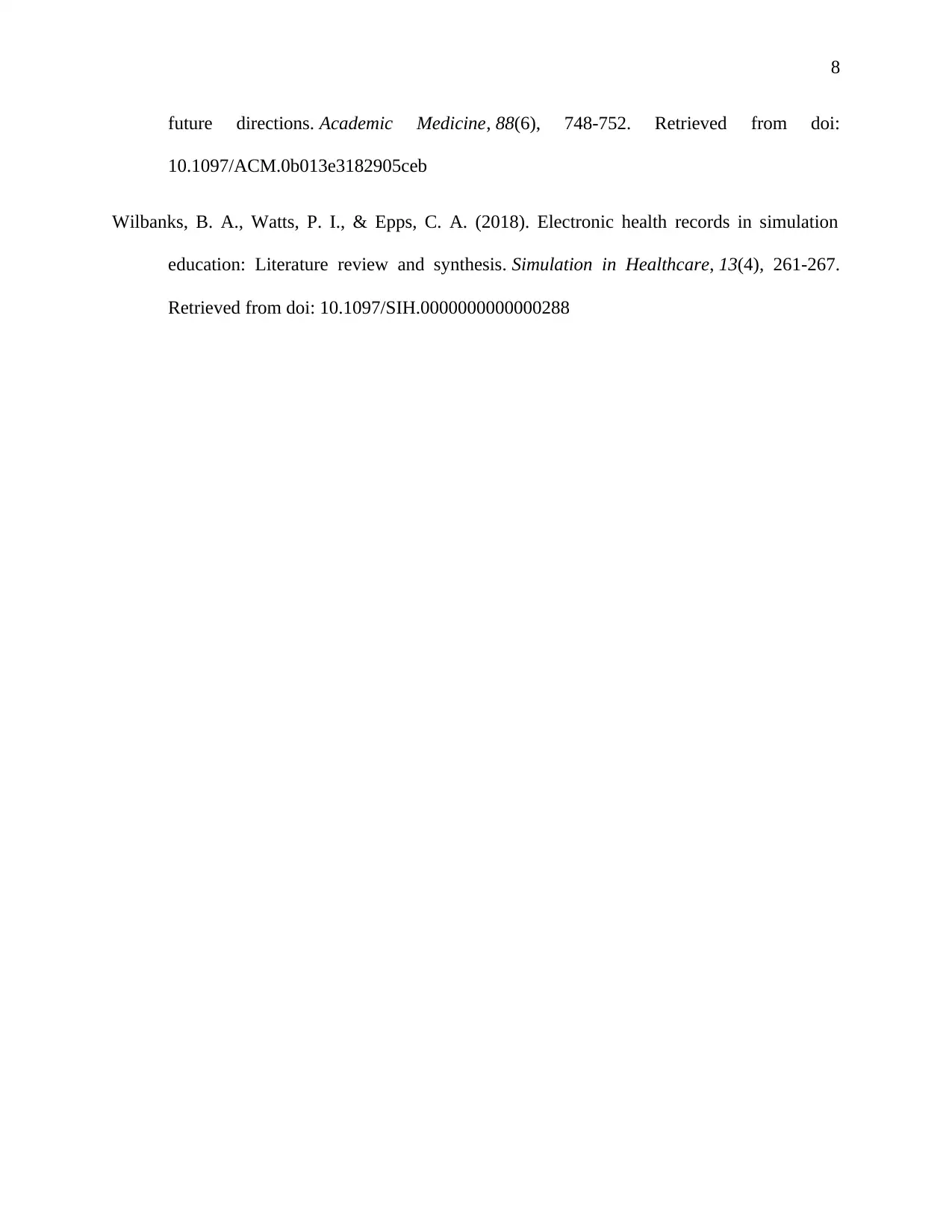
8
future directions. Academic Medicine, 88(6), 748-752. Retrieved from doi:
10.1097/ACM.0b013e3182905ceb
Wilbanks, B. A., Watts, P. I., & Epps, C. A. (2018). Electronic health records in simulation
education: Literature review and synthesis. Simulation in Healthcare, 13(4), 261-267.
Retrieved from doi: 10.1097/SIH.0000000000000288
future directions. Academic Medicine, 88(6), 748-752. Retrieved from doi:
10.1097/ACM.0b013e3182905ceb
Wilbanks, B. A., Watts, P. I., & Epps, C. A. (2018). Electronic health records in simulation
education: Literature review and synthesis. Simulation in Healthcare, 13(4), 261-267.
Retrieved from doi: 10.1097/SIH.0000000000000288
⊘ This is a preview!⊘
Do you want full access?
Subscribe today to unlock all pages.

Trusted by 1+ million students worldwide

9
1 out of 10
Related Documents
Your All-in-One AI-Powered Toolkit for Academic Success.
+13062052269
info@desklib.com
Available 24*7 on WhatsApp / Email
![[object Object]](/_next/static/media/star-bottom.7253800d.svg)
Unlock your academic potential
Copyright © 2020–2025 A2Z Services. All Rights Reserved. Developed and managed by ZUCOL.





